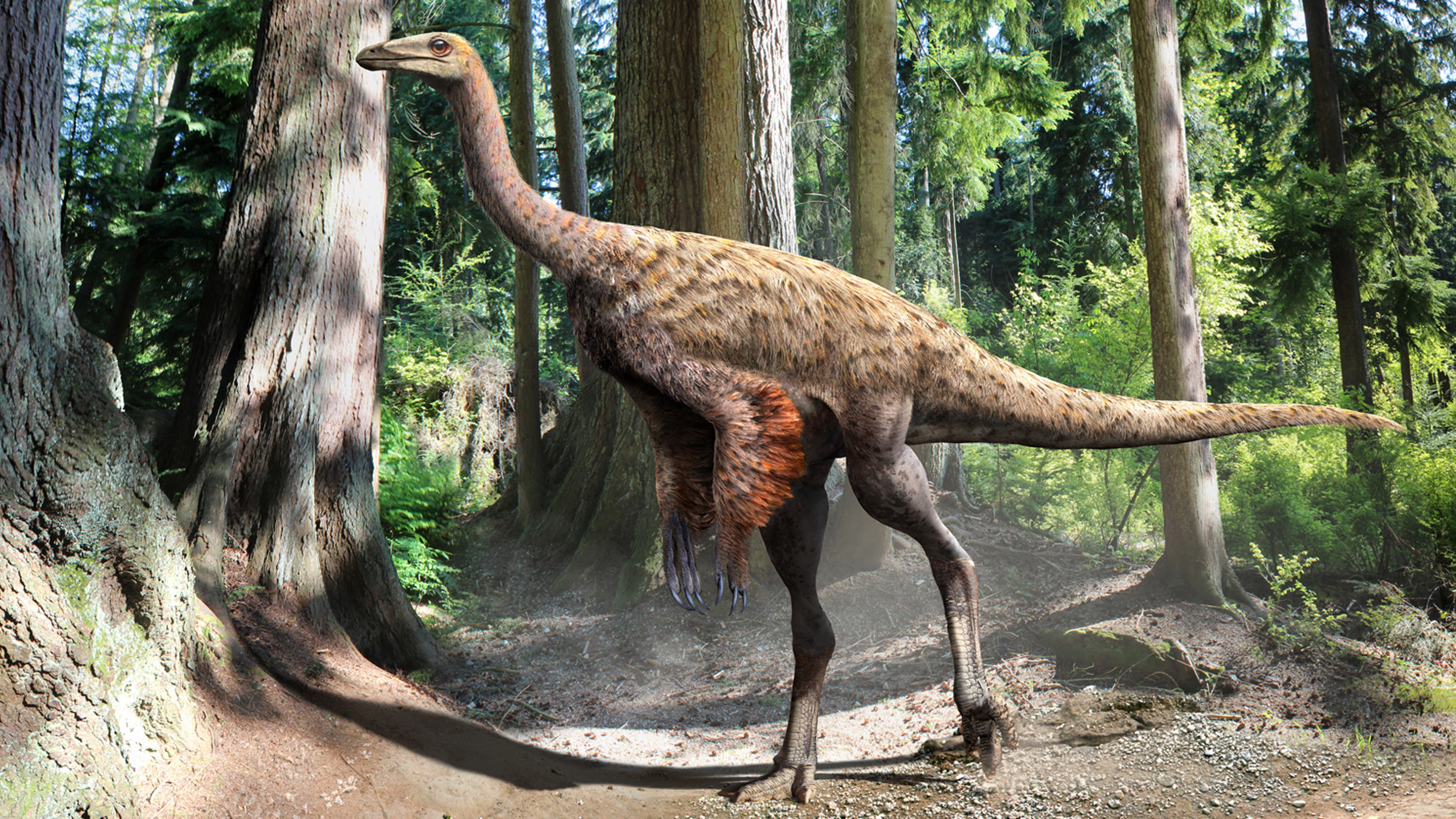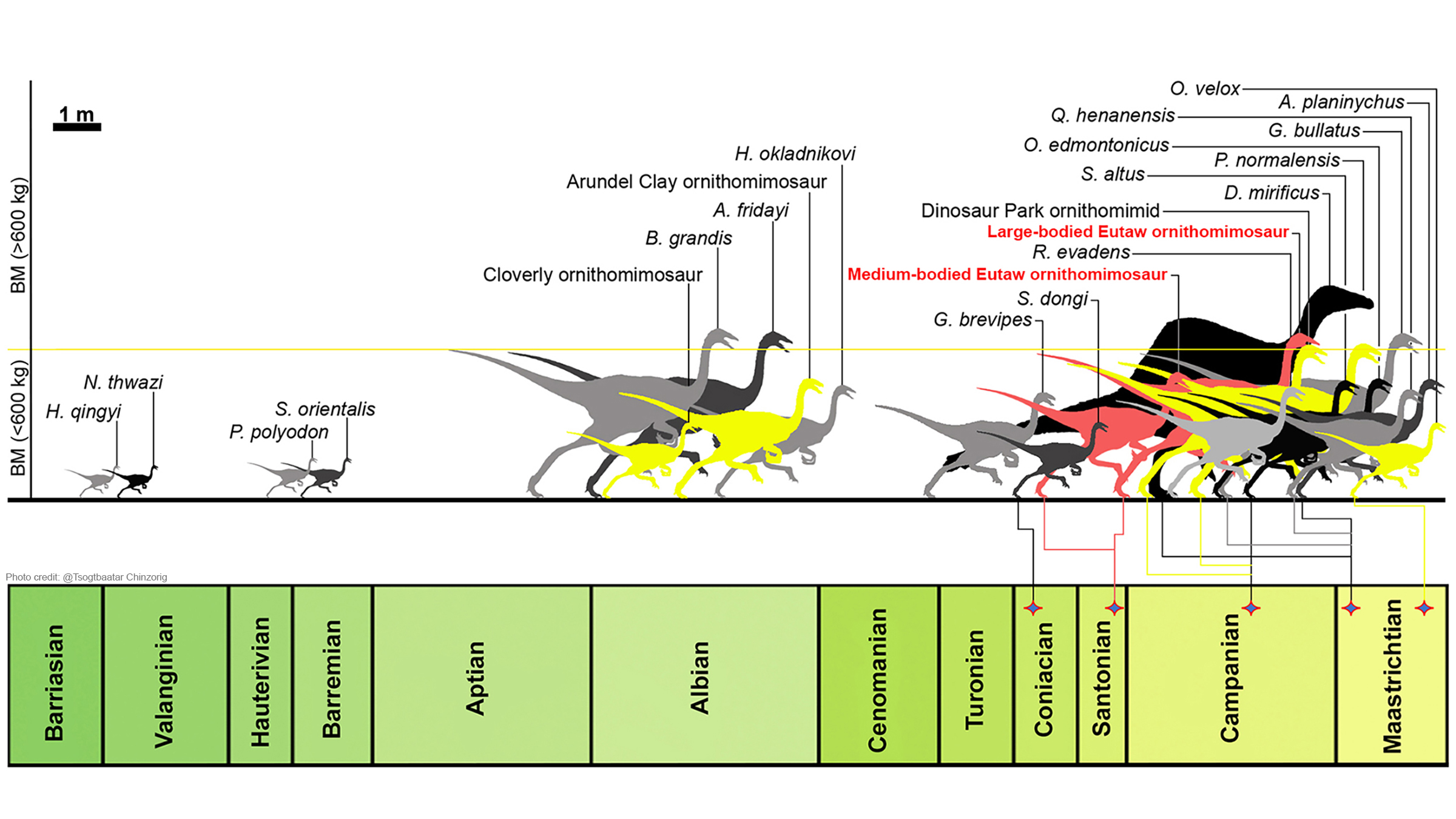Are Ostriches Related To Dinosaurs
Giant, ostrich-like dinosaur and its smaller cousin roamed Mississippi during the belatedly Cretaceous

Two ostrich-like dinosaurs — a towering paleo-beast that was among the largest of its kind, and its smaller, fierce cousin — sprinted through what is now Mississippi nearly 85 million years agone, during the Cretaceous period, new fossil finds reveal.
Scientists still don't know whether these fossils belong to ii previously unknown species of ornithomimosaurs, which is Latin for "bird mimics." But the discovery of the remains is remarkable, given that the ancient landmass they once roamed, essentially what is at present the eastern half of North America, has a poor dinosaur fossil record from the late Cretaceous that's chock-full of broken, hard-to-decipher bones, scientists wrote in a new study.
The finding fills a "disquisitional gap" in the known range and biodiversity of this type of dinosaur from the region during the late Cretaceous (145 million to 66 million years ago), said study lead author Chinzorig Tsogtbaatar, a postdoctoral enquiry scholar in the Department of Biological Sciences at North Carolina Land University.
The fossils as well document "the youngest occurrence of ornithomimosaurs in Appalachia," Tsogtbaatar told Live Science in an electronic mail.
Related: Tsunami from dinosaur-killing asteroid had mile-high waves and reached halfway beyond the world
Ornithomimosaurs are theropods — a group of bipedal, more often than not meat-eating dinosaurs — making them distantly related to the mighty Tyrannosaurus rex. But unlike the hulking, tiny-armed T. rex , ornithomimosaurs were lightly congenital and sported long arms, powerful legs, small skulls and potent beaks — some with teeth and some without, according to the study, published online Wednesday (Oct. 19) in the journal PLOS 1 (opens in new tab).
These omnivores ranged greatly in size, from the colossal Deinocheirus, which stood as tall every bit a iii-story building and measured almost 36 anxiety (eleven meters) long, to pup-size pip-squeaks that were smaller than three feet (i m) long, such as Nqwebasaurus and Pelecanimimus, said Tsogtbaatar, who is as well at the Paleontology Research Lab at the North Carolina Museum of Natural Sciences.

The newly described fossils were unearthed well-nigh Luxapallila (besides spelled Luxapalila) Creek in Lowndes County, Mississippi. Later on comparison the proportions of the fossils and the growth lines within the bones (like trees, dinosaur bones have lines associated with their ages and growth spurts), the researchers concluded that the bones likely belonged to two different ornithomimosaur species — one very large, and the other medium-size.
The larger of the two creatures probable weighed over ane,760 pounds (800 kilograms), and was probably about 10 years old and still growing when it died. This weighty size makes information technology one of the largest ornithomimosaurs on record, the researchers said.
The medium-size dino was likely nearly xx% to fifty% the mass of its bigger counterpart, the team said.
North America divided
When these ornithomimosaurs were live, North America was split in two by the Western Interior Seaway, a vast body of water that separated Laramidia in the W from Appalachia in the E.
In Appalachia during the belatedly Cretaceous, vertebrate remains "tumbled through rivers and streams before they finally got into bounding main sediments. And then they really went through the stone tumbler before they always got to the sea and estuaries and things similar that," Gregory Erickson, a paleobiologist at Florida Country University in Tallahassee who was non involved with the study, told Live Science.
Equally a result, fossils from this period in Appalachia are often scrappy, he said.
"I applaud them [the researchers] for being conservative, too, and not trying to name a new species on scraps that are probably not that diagnostic," Erickson said.
Despite the fossils' poor preservation, the researchers "did a really nice job of looking at these materials and definitively showing that they are ornithomimids," Erickson said. "These are important specimens in the sense of trying to effigy out what kind of radiations the dinosaurs basically isolated on the East Coast were doing."
Are Ostriches Related To Dinosaurs,
Source: https://www.livescience.com/giant-ornithomimosaur-dinosaur-fossils-mississippi
Posted by: jamesabling1956.blogspot.com


0 Response to "Are Ostriches Related To Dinosaurs"
Post a Comment